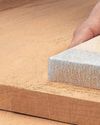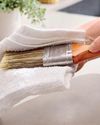Essayer OR - Gratuit
SEALANTS SIMPLIFIED: WHAT TO USE AND WHERE
The Home Handyman
|Jul/Aug'25
Whether you’re tackling a weekend DIY fix, remodelling your home, or involved in large-scale construction, sealants are a silent hero that play a vital role in creating watertight, airtight, and secure finishes.
-

Their purpose goes beyond simply “filling gaps”. Sealants protect joints and surfaces from moisture, dust, vibration, and even extreme temperatures. The right product not only improves the structural integrity of your work but also contributes to long-term durability, reduced maintenance, and improved energy efficiency. To help you navigate the variety of options, here's a breakdown of common sealants, their ideal applications, and why quality matters.
Types of sealants and where to use them
Sealants come in many forms, each tailored to specific tasks and environments. Here’s how to choose wisely:
- Silicone sealants: These are the go-to choice for wet environments such as bathrooms, kitchens, and around windows. They’re flexible, waterproof, and resistant to mould and mildew. It is ideal for areas prone to constant moisture exposure. Silicone is also perfect for sealing glass-to-glass or glass-to-metal joints, offering a long-lasting, crystal-clear finish.
- Polyurethane sealants: Known for their incredible adhesion and durability, polyurethane sealants excel in heavy-duty construction and outdoor applications. They are weather-resistant, paintable, and remain flexible under stress, making them suitable for expansion joints, masonry, concrete, and exterior cladding.
- Acrylic sealants: Ideal for indoor use, especially where painting over the joint is needed. Acrylics are easy to apply, dry quickly, and are perfect for baseboards, drywall cracks, and trim where minimal movement is expected. However, they're not recommended for wet or highly flexible environments.
Cette histoire est tirée de l'édition Jul/Aug'25 de The Home Handyman.
Abonnez-vous à Magzter GOLD pour accéder à des milliers d'histoires premium sélectionnées et à plus de 9 000 magazines et journaux.
Déjà abonné ? Se connecter
PLUS D'HISTOIRES DE The Home Handyman

The Home Handyman
KEEP YOUR HOUSE CRITTER FREE
With winter fast approaching, outdoor critters seeking to regulate their temperature are trying their best to get inside. Ants, spiders, moths, mosquitoes, fruit flies, stink bugs, termites, silverfish, and ladybugs, to name a few, can easily make their way into homes, and once they've settled in, it's often hard to get them out.
6 mins
Jul/Aug'25

The Home Handyman
SECRET HIDEOUTS
We all have things we would prefer to keep out of plain sight - family heirlooms, wedding rings, expensive jewellery, medicines or even weapons. Sometimes we just want to keep household items hidden in order to declutter a space. Whether you want to hide items for safety or financial reasons, or simply want to keep your bedroom tidy, there are a few clever storage ideas that could help you out.
2 mins
Jul/Aug'25

The Home Handyman
ABRASIVES DEMYSTIFIED
Abrasive materials are indispensable in countless industries, from woodworking and metal fabrication to automotive repair and electronics manufacturing.
3 mins
Jul/Aug'25

The Home Handyman
THINNERS VS. TURPENTINE
If you've ever finished a painting or staining job and been left wondering how best to clean your brushes, you're not alone. One of the most common DIY questions is: Should I use thinners or turpentine to clean my brushes? The answer depends on the type of paint or coating you've used. Using the wrong solvent can damage your brushes, or worse, make the cleaning job even harder.
2 mins
Jul/Aug'25

The Home Handyman
KEEP THE COLD OUT
Did you know that homes in South Africa are either insulated to a poor standard, compared to European nations, or have no form of insulation at all. In 2011 our National Building Regulations made it compulsory to fit thermal insulation in new buildings and additions to building structures.
5 mins
Jul/Aug'25

The Home Handyman
ANGLE GRINDERS — MASTERING THIS VERSATILE TOOL
When it comes to versatile tools in a DIYer's arsenal, few can match the power and practicality of the angle grinder.
2 mins
Jul/Aug'25

The Home Handyman
KITCHEN CARE – MAINTENANCE TIPS FOR KEY AREAS
The kitchen is the heart of the home where meals are made, memories are shared, and chaos sometimes reigns. But like any hardworking space, your kitchen needs regular maintenance to keep it functional, safe, and looking great.
2 mins
Jul/Aug'25

The Home Handyman
Separating Fact from Fiction
Maintaining your home can be a daunting task, especially with the plethora of DIY tips and tricks floating around the internet.
2 mins
Jul/Aug'25

The Home Handyman
SEALANTS SIMPLIFIED: WHAT TO USE AND WHERE
Whether you’re tackling a weekend DIY fix, remodelling your home, or involved in large-scale construction, sealants are a silent hero that play a vital role in creating watertight, airtight, and secure finishes.
3 mins
Jul/Aug'25

The Home Handyman
COMMON FRIDGE/FREEZER FAULTS
Your fridge freezer is one of the hardest-working appliances in your home, so when it stops performing as it should, it can cause major inconvenience. The good news? Not every fault means an expensive call-out or a trip to the shops for a new one. In many cases, you can fix the issue yourself with a little know-how and a few basic tools.
3 mins
Jul/Aug'25
Listen
Translate
Change font size
